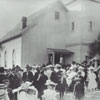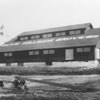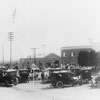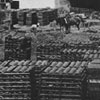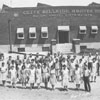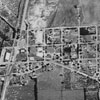|
Brief history about Olive: 1900-1955 BC - 1869
| 1870 - 1899
| 1900 - 1955 | 1956
- PRESENT Citrus groves and the growing community
By the turn of the century, the landscape at Olive was changing due to the well-irrigated land and the presence of the railroad. Circa 1895, Desiderio Burruel's heirs sold a parcel of land west of Olive Grammar School to L.J. Sykes, who developed it as an orange orchard tract. In 1903, the parcel of land south of L.J. Sykes' orchard tract was also developed as an orange tract by German emigrant Henry C. Meyers, who relocated from the Batavia region in Orange to the Olive Ranch area with his wife and son.9 At the age of 67, Louis Schorn sold his interest in the Olive Milling Company and was succeeded as president of the Company by D.C. (Dewitt Clinton) Pixley of Orange.18 The following year, one of the most important churches in Olive was established. St. Paul's Evangelical Lutheran Church was founded on April 7, 1907 (see 1907 photo), and completed a new sanctuary in 1913 (see 2004 photo). A separate building for St. Paul's Lutheran Parochial School (see 2005 photo) was completed in 1922.59 Both structures stand today, in use by North Orange Christian Church at 1001 E. Lincoln Avenue in Orange
As with many other cities in the Orange County region, the ever increasing number of citrus groves in Olive resulted in the construction of packing houses in the community. In 1911, an independent packing house named Growers Fruit Company was built at the northeastern corner of Main and Olive Avenue.65 (See 1912 photo showing the packing house to the right40.) In 1921, this packing house would be bought out by Thomas H. Peppers and his partner A.J. Miller and named Peppers Fruit Company, then Olive Fruit Company two years later. (Source: Tom Pulley) On September 1914 Olive Hillside Groves was founded northwest of this packing house on Railroad Street (see 1915 photo). By November 19 that year, Olive Heights Citrus Association organized and incorporated as a Sunkist packing house,7 and the following year was built to the south of the Olive Hillside Groves packing house. Henry C. Meyers served as one of the original members of the Association's Board of Directors.
Around the time Olive Heights Citrus Association packing house was built, automobiles were on the road, and the Olive Garage and the First National Bank of Olive were established9 near the corner of Hope and Railroad Street (see 1917 photo).23 The Olive Garage structure still stands today, occupied by C.C.c.c. Heating & Air Conditioning since October 1983 (see 2004 photo of the building).24 The Olive Garage business relocated to Orange-Olive Road in the early 1980s, where it continues to operate today (see 2005 photo).54 As progressive changes were continually being made in the Southland, the Olive community became affected by these popular influences. In 1919 the Olive Grammar School was rebuilt in the new Mission style of architecture (see 1927 photo).16
With citrus crops now reigning as king, activity at the flour mill began slowing down. On October 17 that year, the Olive Milling Company was sold to the Central Milling Company of Los Angeles. Less than three years later, Louis Schorn died in Alhambra on April 12, 1922,18 symbolically signifying the end to the legacy of Olive's once prosperous flour mill. Olive began to further develop as a community during the 1920s and became known as the Gateway City because travelers passed through Olive en route to or from Riverside and cities along the Pacific Coast.3 In 1923, a single-story brick structure is built at the northeast corner of Canyon Way (Railroad Street) and Hope (see 1951 photo). This building housed the Olive Mercantile Company general store, Olive Cafe restaurant, Olive Bakery, U.S. Post Office, and Olive Pharmacy and drugstore.59 In 1925 the community had its first newspaper, the Olive Chronicle, which ran for six months.44 Due to the rapid grow in commerce, businesses such as the Clement Lumber Company appeared around this time41 along with Garber Brick Yard (later Mission Clay Products Company),40 operating at the northwestern corner of Hope and Tustin Avenue. The Padre Tile Company (see 1926 photo) began operating at the former site of the second Olive flour mill.25
The Olive community would see a number of fires destroy significant structures throughout the years of its history, having begun with the original flour mill in 1889. On December 16, 1927—a year after Henry Meyers passed away9—the neighboring Olive Hillside Groves and Olive Heights Citrus Association both lost their wooden packing houses to fire. The following year, Olive Hillside Groves rebuilt their packing house at the same site (see 1929 photo),7 but this time Olive Heights Citrus Association rebuilt their packing house of concrete on a parcel from Henry Meyers' estate, across the street and to the west side of the railroad tracks.9 The citrus industry now ruled the rails in the Southland, no longer serving the flour milling industry in Olive, and the styles in architecture were shifting. In 1929, Santa Fe Railway rebuilt its train station to the immediate north of the previous depot, across Olive Heights Citrus Association packing house.40 The single-story, white stucco depot with red tile roof was constructed in the popular Spanish Colonial Revival style (see 1961 photo).39 As for the flour mill, it was dismantled in the spring of 1932,18 the same year in which fire destroyed the Olive Fruit Company packing house.7
On May 21, 1939 the Olive Civic Center, also built in the Spanish Colonial Revival style, was dedicated in Olive (see 2004 photo).28 This building also became known as the Olive Community Center and Assembly Hall, and the Olive Grammar School's Gymnasium and Auditorium,29 and still stands today on the grounds of Olive Elementary School (see photo). Olive would have its fifth and last packing house firm—Lawrence Kokx—come to town in 1945 (source: Tom Pulley), and in 1948 would have its last fire station—Fire Station #20 (Olive Volunteer Fire Dept.)—built of adobe bricks (see 1982 photo).30 In 1953, Olive Grammar School became a part of the Orange Unified School District16 and was officially named Olive Elementary School.31 During this decade, the direction of the Olive community would change once again, as the citrus industry began winding down. _______________________________________________ |
||||||||||||||||||||||||||||||||
| Copyright © 2005 - Daralee's Web World. All rights reserved. | ||||||||||||||||||||||||||||||||
